- Egypt Tour Magic
- Egypt Tour Packages
- Excursions in Egypt
- Cairo Tours and Excursions
- Hurghada Tours and Excursions
- Soma Bay Tours and Excursions
- Makadi Bay Tours and Excursions
- Sahl Hasheesh Tours and Excursions
- El Gouna Tours and Excursions
- Marsa Alam Tours and Excursions
- Port Ghalib Tours and Excursions
- El Quseir Tours and Excursions
- Dendera and Abydos Day Tours
- Aswan Tours and Excursions
- Luxor Tours and Excursions
- Alexandria Tours and Excursions
- Sharm El Sheikh Tours and Excursions
- Top Rated Tours in 2025
- Optional Excursions in Egypt
- Private Transfer
- Blogs About egypt
- Ancient Egypt
- What You Need To know Before Your First Trip To Egypt
- Best Places to Visit in Egypt 2025
- Top Attractions in Red Sea Resorts 2025
- Top 10 Tourist Activities in Egypt
- Top 30 Activities You Can’t Miss in Egypt
- The Guide to Guided Tours in Egypt
- Egypt’s Ancient and Modern History
- The Nile River
- The Deserts of Egypt
- Historical Sites in Egypt
- Cairo
- Alexandria
- Luxor
- Aswan
- The Red Sea
- Dendera Temple
- El Fayoum Oasis
- Bahariya Oasis
- Siwa Oasis
- Al Alamein
- Marsa Matruh
- Ancient Egyptian gods
- famous Egyptian dishes
- UNESCO World Heritage sites
- About Us
- Why Egypt Tour Magic
- Egypt Tour Magic
- Egypt Tour Packages
- Excursions in Egypt
- Cairo Tours and Excursions
- Hurghada Tours and Excursions
- Soma Bay Tours and Excursions
- Makadi Bay Tours and Excursions
- Sahl Hasheesh Tours and Excursions
- El Gouna Tours and Excursions
- Marsa Alam Tours and Excursions
- Port Ghalib Tours and Excursions
- El Quseir Tours and Excursions
- Dendera and Abydos Day Tours
- Aswan Tours and Excursions
- Luxor Tours and Excursions
- Alexandria Tours and Excursions
- Sharm El Sheikh Tours and Excursions
- Top Rated Tours in 2025
- Optional Excursions in Egypt
- Private Transfer
- Blogs About egypt
- Ancient Egypt
- What You Need To know Before Your First Trip To Egypt
- Best Places to Visit in Egypt 2025
- Top Attractions in Red Sea Resorts 2025
- Top 10 Tourist Activities in Egypt
- Top 30 Activities You Can’t Miss in Egypt
- The Guide to Guided Tours in Egypt
- Egypt’s Ancient and Modern History
- The Nile River
- The Deserts of Egypt
- Historical Sites in Egypt
- Cairo
- Alexandria
- Luxor
- Aswan
- The Red Sea
- Dendera Temple
- El Fayoum Oasis
- Bahariya Oasis
- Siwa Oasis
- Al Alamein
- Marsa Matruh
- Ancient Egyptian gods
- famous Egyptian dishes
- UNESCO World Heritage sites
- About Us
- Why Egypt Tour Magic
Discover the Timeless Magic of Alexandria
Nestled along the sun-drenched shores of the Mediterranean, Alexandria is a city that blends antiquity with coastal charm like no other. Once the intellectual heart of the ancient world and home to wonders like the Great Library and the Lighthouse of Pharos, Alexandria continues to captivate visitors with its rich cultural heritage, unique architecture, and breezy seafront ambiance. Founded by Alexander the Great in 331 BC, this historic city has served as a crossroads of civilizations—Greek, Roman, Egyptian, and Islamic—all leaving behind layers of stories, monuments, and traditions that make every street and stone feel like a page from a living history book.
But Alexandria is more than just its glorious past. It’s a dynamic urban hub where bustling markets, grand mosques, elegant cafés, and seaside promenades come together to create a destination that is both deeply rooted and refreshingly vibrant. Whether you’re a history enthusiast, a seeker of serene gardens, a fan of majestic architecture, or simply someone looking to enjoy the Mediterranean breeze, Alexandria has something for everyone.
In this guide, we take you through the Top 9 Things to Do in Alexandria—a curated list of must-visit places that showcase the city’s enduring spirit, its architectural wonders, and the charm that continues to make it one of Egypt’s most treasured destinations. From the legendary Bibliotheca Alexandrina to hidden catacombs, Roman ruins, Ottoman palaces, and spiritual sanctuaries, these experiences promise to enrich your journey and leave you with unforgettable memories of Egypt’s enchanting second city.
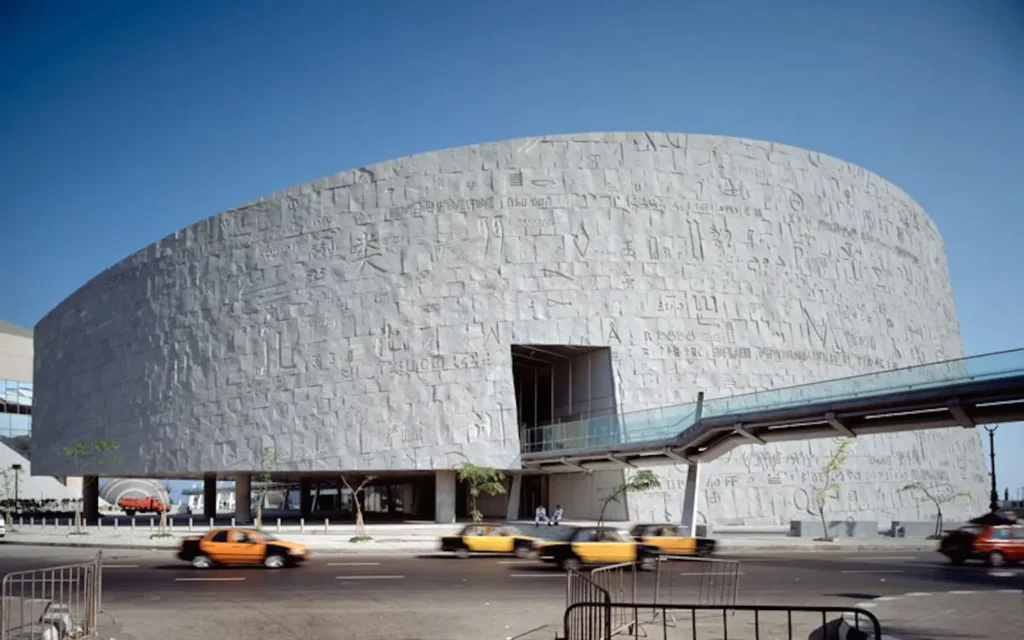
1. Bibliotheca Alexandrina (Modern Library of Alexandria)
The Bibliotheca Alexandrina is more than just a library—it is a symbol of rebirth, knowledge, and cultural dialogue. Located on the shores of the Mediterranean, this strikingly modern building was inaugurated in 2002 as a tribute to the ancient Great Library of Alexandria, which was one of the largest and most significant libraries of the ancient world. Its unique disc-like design, resembling a rising sun, reflects its mission of enlightenment. The complex holds a vast main reading hall that can accommodate over 2,000 readers and houses millions of books in multiple languages. But the Bibliotheca is not only about books. It includes specialized libraries for the blind and children, several museums (like the Antiquities Museum and Manuscript Museum), art galleries, and a planetarium. Throughout the year, it hosts lectures, exhibitions, and cultural events, making it a vibrant hub for scholars, students, and tourists alike. The architecture alone is worth the visit, with its massive granite wall carved with letters from hundreds of alphabets around the world. Visitors come to witness its blend of history, technology, and learning under one roof. A guided tour is highly recommended to fully grasp the scope of its facilities. For anyone traveling to Alexandria, the Bibliotheca is an unmissable destination—a place where ancient history meets future aspirations, reviving the legacy of a city that once stood at the crossroads of science, philosophy, and literature.
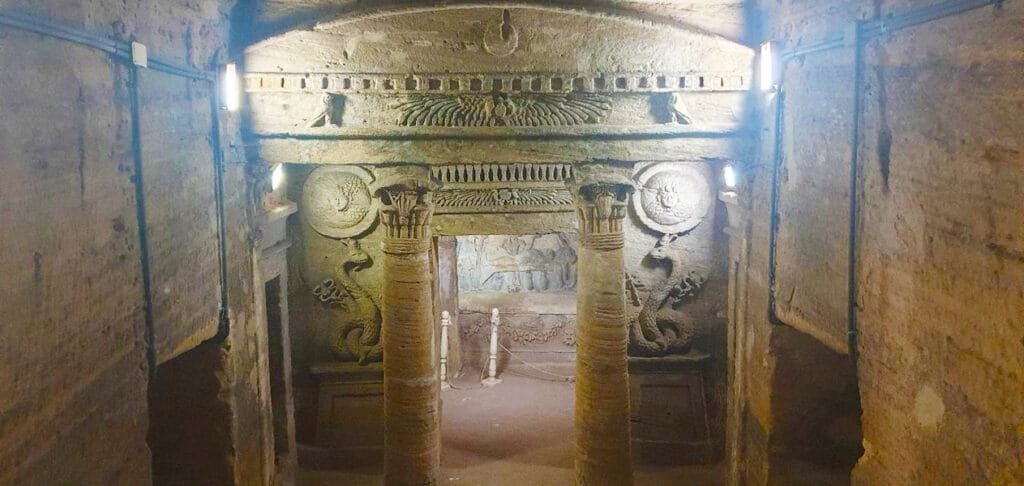
2. Catacombs of Kom el‑Shoqafa
The Catacombs of Kom el-Shoqafa are one of the most extraordinary archaeological sites in Alexandria, offering a surreal underground journey through layers of cultural fusion. Discovered in 1900, these catacombs date back to the 2nd century AD and are a unique blend of Egyptian, Greek, and Roman styles, reflecting Alexandria’s diverse identity during the Roman period. The complex consists of a spiral staircase leading down into a multilevel burial site carved into the bedrock. The first level houses a rotunda and banquet hall, where relatives of the deceased would hold feasts in their memory. The second level, now partially submerged, contains beautifully sculpted tombs, niches, and sarcophagi adorned with hybrid art—Roman togas mixed with Egyptian headdresses and Greek decorative elements. Perhaps the most iconic chamber is the Hall of Caracalla, believed to be a mass burial site for soldiers and animals. The quiet, damp atmosphere of the catacombs, combined with flickering lights, gives visitors a chilling yet fascinating sense of how the ancient Alexandrians honored their dead. The Catacombs also reveal much about the religious transitions of the time, showcasing funerary practices, beliefs in the afterlife, and the adaptation of Hellenistic styles within Egyptian funerary traditions. What makes this site particularly striking is how it visually narrates the multicultural fabric of ancient Alexandria. Unlike anything else in Egypt, this blend of Greco-Roman design with Egyptian burial customs makes Kom el-Shoqafa a rare archaeological gem. Visiting the site offers a deeper understanding of Alexandria’s layered past and how the city served as a melting pot for civilizations.
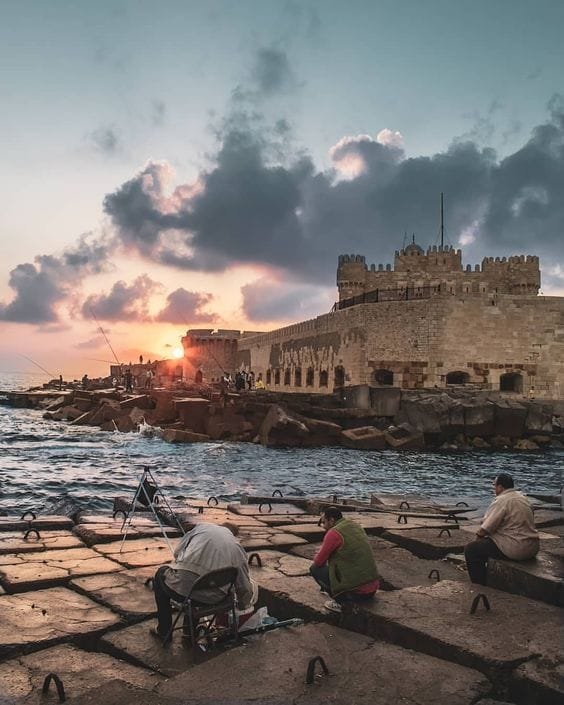
3. Citadel of Qaitbay
Built in 1477 by Sultan Qaitbay on the exact site of the ancient Lighthouse of Alexandria (Pharos), the Citadel of Qaitbay stands as a proud guardian of the Mediterranean coast. The lighthouse, once considered one of the Seven Wonders of the Ancient World, was destroyed by earthquakes, and the citadel was constructed using some of its stones. Located at the western tip of the Corniche on Pharos Island, this majestic fortress played a critical defensive role in protecting Alexandria from maritime invasions during the Mamluk and Ottoman periods. The citadel’s thick walls, commanding towers, and strategic design reflect advanced military architecture of its time. Visitors can walk through its courtyards, climb to its upper terraces, and enjoy panoramic views of the Mediterranean Sea and Alexandria’s bustling harbor. Inside, you’ll find a small maritime museum and several chambers that once housed soldiers and weaponry. While much of the original structure has been restored over the centuries, it still retains its medieval charm and historical gravity. The location of the Citadel also makes it a favorite for photographers and history enthusiasts alike. Watching the waves crash against the rocky base of this ancient fortification, it's easy to imagine ancient ships approaching the city and the lighthouse’s great flame guiding them safely to shore. Today, the Citadel of Qaitbay is not only an architectural marvel but a symbolic bridge between Alexandria’s ancient grandeur and its Islamic heritage. It is one of the most iconic landmarks of the city, ideal for a leisurely exploration of history wrapped in sea breeze and stone walls.
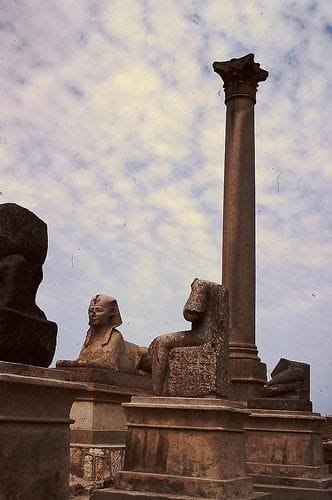
4. Pompey’s Pillar & the Serapeum
Pompey’s Pillar is one of Alexandria’s most iconic ancient landmarks—a towering granite column standing 27 meters high and dating back to the 3rd century AD. Despite the name, the pillar has nothing to do with the Roman general Pompey. It was actually erected in honor of Emperor Diocletian by the people of Alexandria for saving the city from a famine. The pillar once stood within the grand Temple of Serapis, known as the Serapeum, which was the most important religious sanctuary in ancient Alexandria during the Greco-Roman era. Today, while the temple itself lies in ruins, the pillar remains a striking symbol of Alexandria’s imperial history. Surrounding the column are remnants of the Serapeum, including underground galleries, sphinxes, and a few preserved statues that speak of the grandeur of what was once a bustling spiritual center. A visit to the site provides a unique look at Alexandria’s transition from a Hellenistic city to a Roman metropolis. The Serapeum was dedicated to Serapis, a Greco-Egyptian deity created to unite the two cultures under the Ptolemies. The fusion of architecture, religion, and symbolism found here reflects the city’s cosmopolitan roots. From the elevated site of the pillar, visitors can also enjoy panoramic views of the surrounding cityscape. Although less elaborate than other ancient sites, Pompey’s Pillar is significant for its resilience—it’s the only remaining freestanding column of its kind in Egypt. For those intrigued by Alexandria’s classical period, this location is a must-see. It offers a glimpse into the city’s political, religious, and cultural complexity and serves as a powerful reminder of the city’s ancient prestige.
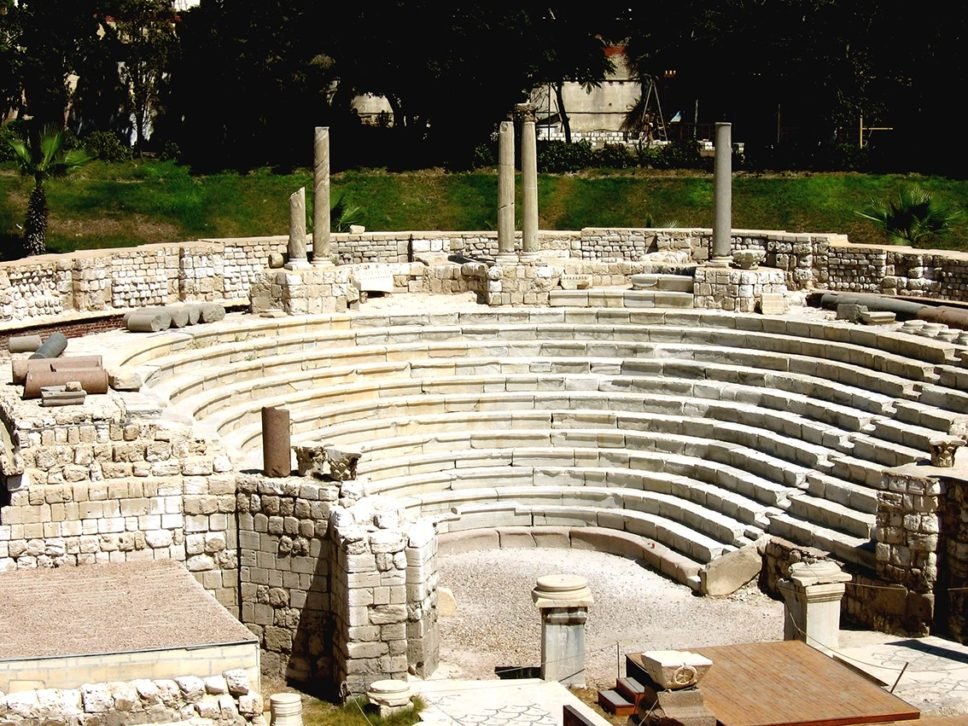
5. Kom el-Dikka (Roman Theater and Bath Complex)
Kom el-Dikka is an archaeological treasure in the heart of modern Alexandria, revealing layers of Roman civilization hidden beneath a residential hill until the mid-20th century. The name “Kom el-Dikka” means “Mound of Rubble,” a fitting title before its excavation unveiled a sprawling complex that includes a well-preserved Roman theater, lecture halls, Roman villas, bathhouses, and intricate mosaics. The centerpiece is the semi-circular marble Roman theater, complete with 13 tiers of seats, mosaic flooring, and a small stage, used for musical performances and public meetings. It's the only structure of its kind in Egypt and showcases Roman influence on the city’s public life and entertainment culture. Adjacent to the theater is the Bath Complex, with evidence of hot and cold rooms (caldarium and frigidarium), and nearby cisterns and drainage systems illustrating the advanced engineering skills of the Romans. Equally fascinating are the remains of lecture halls and auditoriums believed to be part of the ancient university district of Alexandria, emphasizing the city’s long-standing dedication to education. Kom el-Dikka also includes elite residential homes known as the “Villa of the Birds,” named for its well-preserved mosaic of colorful birds that remains almost intact after centuries. Walking through Kom el-Dikka is like stepping into an open-air museum. The site is not only visually impressive but rich in stories that reflect daily life in ancient Roman Alexandria—from the art of performance to bathing rituals to education. It’s a reminder that Alexandria was not only a hub of Hellenistic culture but also flourished under Roman rule, leaving behind a tangible legacy of urban sophistication.
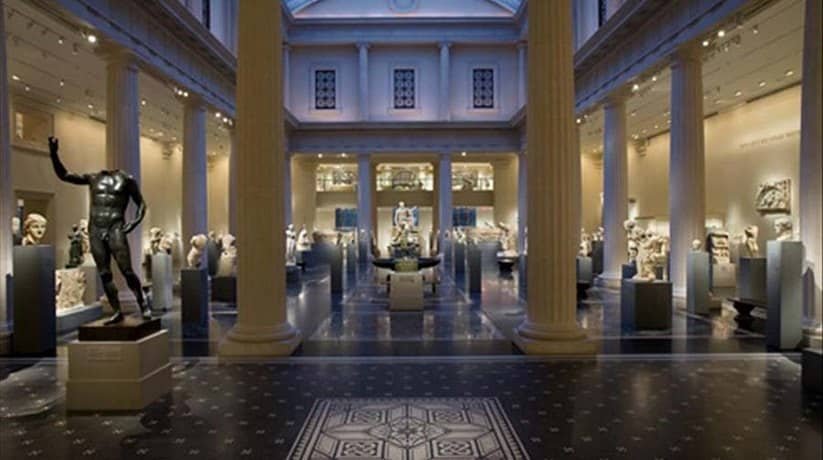
6. Graeco-Roman Museum
The Graeco-Roman Museum is a centerpiece of Alexandria’s historical narrative, showcasing the city’s Greco-Roman heritage through an expansive collection of over 40,000 artifacts. Established in 1892 and recently reopened after years of renovation, the museum is housed in a neoclassical building that offers visitors an immersive journey through centuries of Alexandria’s cosmopolitan past. The museum’s displays highlight the fusion of Greek, Roman, and Egyptian cultures—a defining characteristic of Alexandria. Inside, you’ll find statues of emperors, busts of philosophers, Greco-Egyptian deities like Serapis, terracotta figures, coins, jewelry, and funerary stelae, many discovered in local digs such as Kom el-Dikka and the Catacombs of Kom el-Shoqafa. Particularly impressive are the statues of Ptolemaic rulers and Roman emperors, as well as depictions of the Alexandrian version of Isis. The museum is arranged thematically, making it easy to trace the evolution of art, religion, and society from the city’s founding under Alexander the Great through the Roman occupation. There’s also a section dedicated to ancient writing systems and papyri, which gives visitors insight into administrative and scholarly life. Beyond the objects themselves, the museum tells a larger story of Alexandria’s unique place in ancient history—where East met West, where Egyptian gods wore Greek robes, and where philosophers debated in multicultural forums. The museum serves both as a guardian of relics and an educational center, offering context that brings Alexandria’s past vividly to life. Whether you're a history enthusiast or a casual visitor, the Graeco-Roman Museum offers an enriching, informative, and deeply cultural experience that anchors the city’s heritage in a tangible and inspiring way.
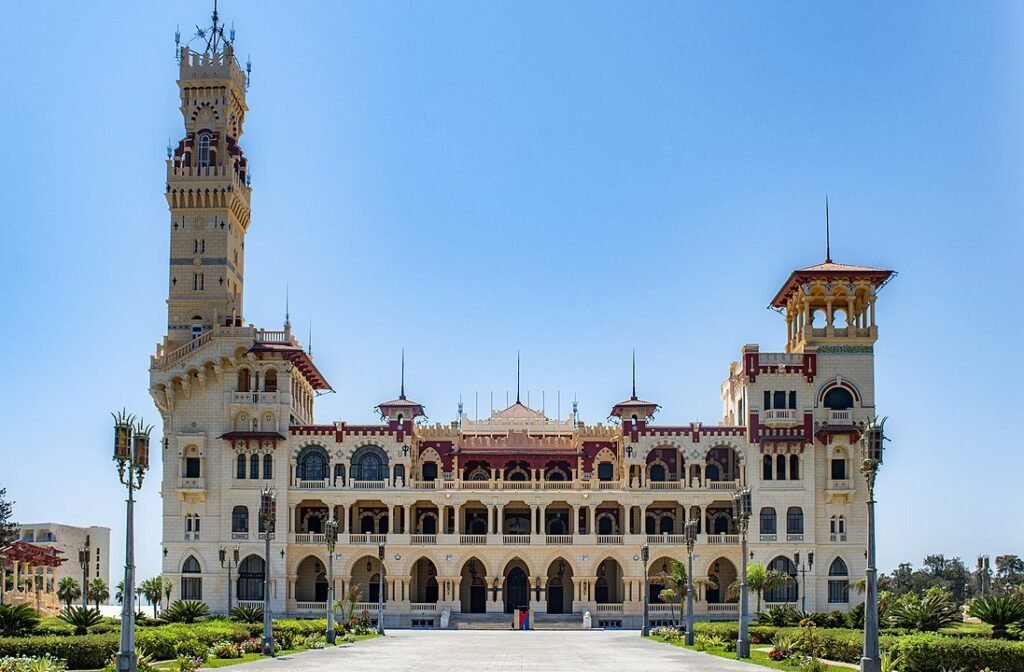
7. Montazah Palace Gardens & Stanley Bridge
The Montazah Palace Gardens are among the most beautiful and relaxing places in Alexandria. Spanning over 150 acres of lush greenery and Mediterranean coastline, this royal retreat combines majestic architecture with breathtaking landscapes. The centerpiece is the Montazah Palace, built by Khedive Abbas II in 1892 as a summer residence. Its architectural style blends Ottoman and Florentine elements, giving it a fairy-tale charm. While the palace itself is closed to the public, the surrounding gardens are open and meticulously maintained, offering shaded walkways, exotic palm trees, flower beds, and sea views that invite long, tranquil strolls. Families, couples, and tourists alike come here for picnics, relaxation, and photography. The gardens lead down to private beaches and rocky coves, and the area is dotted with vintage royal cabins, once used by the Egyptian elite. A visit during sunset makes for an unforgettable experience, as the golden light bathes the gardens and reflects on the sea. Just a short distance away is the stunning Stanley Bridge, another architectural gem and one of the most photographed spots in Alexandria. Built in the early 2000s, this four-towered bridge spans a stretch of the Corniche and offers panoramic views of the coastline. The bridge is designed in a neo-Arabesque style, matching the character of Montazah and giving the modern city a nostalgic flair. At night, Stanley Bridge is beautifully illuminated, and many visitors enjoy a relaxing walk along its length, stopping for ice cream, roasted corn, or coffee from local vendors. Together, Montazah and Stanley Bridge represent the romantic, scenic side of Alexandria—a city known not only for its ancient heritage but also for its royal elegance and seaside charm. It’s an ideal escape from the noise of the city, offering serenity with a touch of grandeur.

8. Stroll the Corniche
Walking along the Alexandria Corniche is one of the most authentic ways to experience the spirit of the city. Stretching more than 10 miles along the Mediterranean Sea, the Corniche runs from the Eastern Harbor past the Citadel of Qaitbay, the Bibliotheca Alexandrina, and many historic neighborhoods, ending near Montazah. This coastal promenade offers scenic views, salty breezes, and an ever-changing panorama of daily Egyptian life. It’s where locals come to fish, sell snacks, enjoy the sea air, or sit on the sea wall to watch the waves crash. For visitors, it offers an immersive journey through Alexandria’s living soul. Along the Corniche, you’ll find charming old cafés that have served generations of Alexandrians, seafood restaurants offering freshly caught fish, and markets where you can sample local flavors. The Corniche also connects many of Alexandria’s historical and cultural landmarks, making it perfect for a self-guided walking tour. Start at the Citadel of Qaitbay for stunning views of the harbor, then pass by the Abu Abbas al-Mursi Mosque with its intricate Islamic architecture. Continue along the coastline to reach the famous Cecil Hotel, a relic of colonial elegance, and eventually arrive at the striking Bibliotheca Alexandrina. The Corniche’s mix of architecture—colonial buildings, modern towers, and faded Belle Époque apartments—tells the story of a city that has embraced both the past and the future. During the evening, the Corniche becomes especially lively. Families come out for a stroll, street performers appear, and the sea breeze offers a welcome relief from the heat. Whether you walk its full length or just enjoy a short sunset stroll, the Alexandria Corniche offers a sense of place like no other—one where history, daily life, and the beauty of the sea come together seamlessly.

9. Abu Abbas al-Mursi Mosque
The Abu Abbas al-Mursi Mosque is one of Alexandria’s most spiritually significant and visually striking landmarks. Located in the Anfoushi district near the Corniche and the Citadel of Qaitbay, this mosque honors the Andalusian Sufi saint Abu al-Abbas al-Mursi, who lived and taught in Alexandria during the 13th century. Originally built in 1307 over the saint’s tomb, the mosque has been reconstructed multiple times, with its current form dating back to the 1940s. It stands out with its creamy white facade, towering minaret, and beautifully intricate arabesque designs, making it a masterpiece of Islamic architecture. The mosque’s domes and arches are adorned with finely detailed geometric and floral patterns, and the calligraphy inside is mesmerizing. Its massive prayer hall features stained glass windows, chandeliers, and elegant marble columns, offering a serene environment for worshippers and visitors alike. The mosque remains active as a place of prayer and spiritual reflection, and its atmosphere is one of reverence and peace. While non-Muslims may not always be allowed inside during prayer times, the exterior alone is worth the visit. The mosque is a favorite subject for photographers thanks to its unique design and historic significance. The area surrounding the mosque is equally fascinating. You’ll find traditional cafés, street vendors selling sweets and dates, and views of fishing boats in the nearby harbor. It’s a perfect stop for those interested in Alexandria’s Islamic heritage and the city’s vibrant local life. Visiting the Abu Abbas Mosque offers a chance to connect with Alexandria’s spiritual past and present. It stands as a beacon of faith and culture, reminding visitors that Alexandria isn’t just about ancient ruins and modern libraries—it’s also a living, breathing city where faith and community remain at the heart of daily life.


